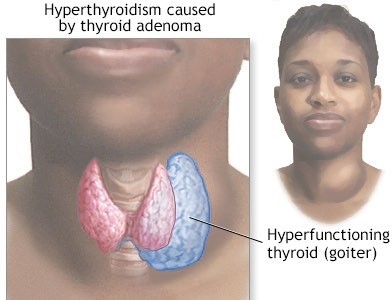A 40-year-old female client has a family history of "thyroid problems" and is being seen by the primary healthcare provider for unintentional weight loss, irritability, and chest discomfort. Her probable diagnosis is hyperthyroidism, which the primary healthcare provider plans to confirm by laboratory testing.
What additional physical assessment findings would the nurse expect to be present in this client?
Select all that apply.
Diaphoresis
Insomnia
Hypotension
Decreased deep tendon reflexes.
Constipation
Correct Answer : A,B,E
Answer c is incorrect because hyperthyroidism typically causes hypertension, not hypotension. Answer d is also incorrect because hyperthyroidism typically causes increased, not decreased, deep tendon reflexes. Answer f is incorrect because hyperthyroidism typically causes diarrhea, not constipation.

Nursing Test Bank
Naxlex Comprehensive Predictor Exams
Related Questions
Correct Answer is ["A","B","E"]
Explanation
Answer c is incorrect because hyperthyroidism typically causes hypertension, not hypotension. Answer d is also incorrect because hyperthyroidism typically causes increased, not decreased, deep tendon reflexes. Answer f is incorrect because hyperthyroidism typically causes diarrhea, not constipation.

Correct Answer is ["D","F","G"]
Explanation
Option A is incorrect because administering an ACE inhibitor may be a part of the patient's regular medication regimen, but it is not specific to preventing complications of diabetes mellitus while in the hospital.
Option b is incorrect because administering intravenous fluids at a high rate may result in fluid overload, electrolyte imbalances, and other complications, which may not be appropriate for this patient.
Option c is incorrect because administering glucagon is not a preventative measure, but rather an intervention for treating hypoglycemia.
Option d is correct because ensuring a well-lit path to the bathroom is important for fall prevention, but it does not directly address the prevention of complications of diabetes mellitus.
Option e is incorrect because encouraging the client to drink sugar-free liquids is a general recommendation for maintaining hydration and may not be specific to preventing complications of diabetes mellitus.
Option f is correct because teaching the client to rise slowly from the bed is important for preventing orthostatic hypotension, but it does not directly address the prevention of complications of diabetes mellitus.
Option g is correct because Patients with diabetes mellitus are at risk for hypoglycemia when taking insulin or oral hypoglycemic agents. Proper coordination of meal-time insulin with food delivery and consumption can help prevent hypoglycemia or hyperglycemia. This includes ensuring that the patient receives insulin at the appropriate time in relation to meals and monitoring blood glucose levels regularly.
Whether you are a student looking to ace your exams or a practicing nurse seeking to enhance your expertise , our nursing education contents will empower you with the confidence and competence to make a difference in the lives of patients and become a respected leader in the healthcare field.
Visit Naxlex, invest in your future and unlock endless possibilities with our unparalleled nursing education contents today
Report Wrong Answer on the Current Question
Do you disagree with the answer? If yes, what is your expected answer? Explain.
Kindly be descriptive with the issue you are facing.
